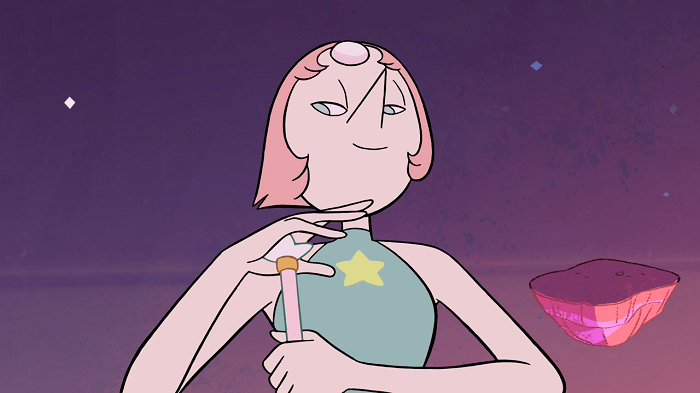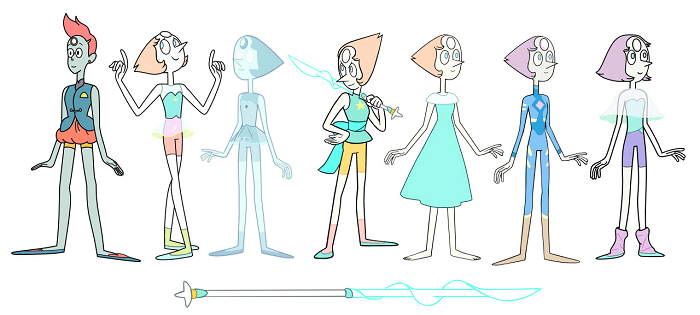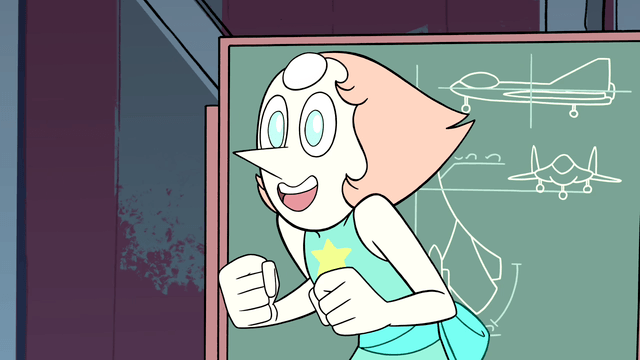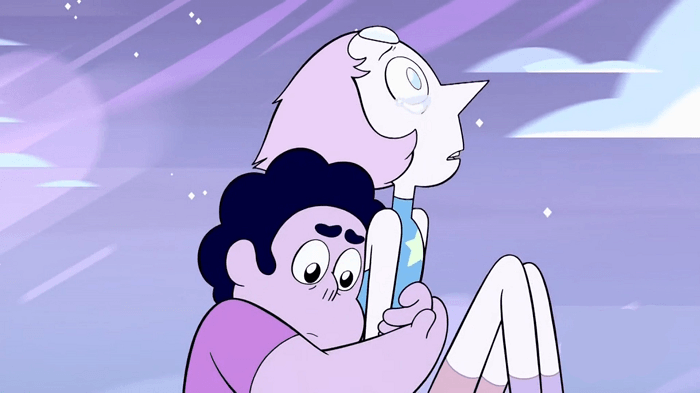If you’re an animator searching for the secret formula to diversity, you couldn’t do much better than taking notes from Rebecca Sugar’s Steven Universe. Just the sheer number of non-white voice actors and characters alone is astounding (and that’s before delving into the topics of gender, sexuality, and alternative family styles). By itself coding animated characters as people of color without resorting to harmful stereotyping, especially in a majority white society, can be challenging to the say the least. Equally important, however, is the ability to include depictions of people of color that challenge our notions of even commonly accepted attributes or bring fresh insight to repeated narratives. It stands to reason that in a time where activism-centered hashtags like #WeNeedAAPIStudies fight for educational equality we also need to reclaim representation in arts and entertainment instead of letting whiteness be the cultural default. Enter Pearl.
One of the main obstacles stopping people from accepting a POC interpretation comes from Pearl’s physical characteristics. Even with their shapeshifting abilities, though, none of the gems’ skintones allow them to successfully pass for human except for Rose Quartz (yes, former supervising director Ian Jones-Quartey explained this as having to do with some forms of rose quartz being peach in color, but that sounds suspiciously convenient) and possibly Amethyst as a person with argyria. Garnet, contrary to many fan artist depictions, is actually a deep maroon as opposed to brown. In addition Garnet’s non-existent waist, three different colored eyes, and cubic hair are in no way common to Black people yet she’s still classified with this coding. Pearl’s pale blue skin, blue eyes, and peach-pink hair ought to be equally irrelevant, then.
While the Gems’ non-human skintones in general allow viewers to align Pearl with any nationality, much of the evidence points to Asian origins. For one, just as part of Garnet’s coding has been established by her Black voice actress Estelle, Pearl’s voice actress Deedee Magno Hall is Filipina. Some fan theories even point to the fact that Pearl’s physical traits make her look strikingly similar to Sunmi in the “24 Hours” video (a song creator Rebecca Sugar explicitly stated was one of Pearl’s themes), and both even share a distinct, sharply angled nose. Many of Pearl’s motifs are Asian in origin as well. For instance, in the first episode of the series, entitled “Gem Glow,” Pearl teaches Steven about wielding gem weapons in front of what appears to be a large blossoming cherry tree. Given Sugar’s extensive anime fandom background it’s easy to call this moment an intentional homage. Pearl’s obi-like sash appears to be a Japanese reference, too.
Read from this angle, then, Pearl’s story as an immigrant from a civilization whose rich culture she is desperate to preserve and pass down to the next generation while struggling to assimilate into her new home becomes the familiar longing for one’s homeland (Deedee Magno Hall herself was born to immigrant parents). An Asian-coded Pearl also adds another layer to the complexity of her mentorship to Connie Maheswaran and the ways with which her parenting style tends to overlap with Dr. Maheswaran’s; rather than the tired Tiger Mom trope, Pearl’s strictness comes across instead as a devotion to excellence that balances with a sensitive, family-oriented nature.
An Asian-coded Pearl also allows audiences to view aspects of her personality that are often taboo in Asian cultures in a favorable light. For instance, given her romantic attraction to Rose Quartz, this reading creates one of the few positive open depictions of a non-fetishized, non-villainized queer Asian woman in media. Similarly, coding Pearl as Asian allows for an important investigation into her defining characteristics as a “neurotic and uptight” individual (as specifically defined by the episode “Reformed”). While thankfully the term “neurotic” has been dying out in the last few centuries, it’s not outlandish to suggest that out of all the Steven Universe protagonists Pearl most closely demonstrates a struggle with mental and emotional health; her violent reaction to Amethyst’s disturbance of order in “Mirror Gem” and her emotional breakdown in “Rose’s Scabbard” are merely a few of a myriad of examples.
According to an impressive list of Asian mental health statistics gathered by curator of the activist website Reappropriate, Jenn Fang, as many as 10% of Asian Americans have reported symptoms of depression yet only 2-4% would seek help from a professional (you can find the rest of the list here). One study even found that across the board Asian American women had higher suicide rates than the national average, and while Pearl’s continual sacrifice for Rose can be seen as noble, we also know from “Sworn to the Sword” that putting her easily accessible gem at risk was informed by a self worth appraised as “nothing.” When we see Pearl become willing to depend and trust her friends to support her in an attempt to build emotional stability, then, we’re witnessing necessary encouragement for people who live with mental illness as well as their loved ones to learn at any age. More broadly, similar statistics in other non-white communities amplify the significance of Pearl as POC-coded in general.
Finally, both Jasper and Peridot’s insistence that Pearl’s developed personality is “defective” because it diverges from a cultural norm replicates what Asian Americans endure constantly; Pearl’s expected passivity and obedience are just a few of the traits held in common. Yet by Pearl asserting her individualism counter to a society teaching that she should be viewed as a literal model minority we as an audience are forced to reconcile this image in our minds. As author Arissa Oh so eloquently tweeted:
#alllooksame, all the same, all Confucian and hardworking and whatever… We are an undifferentiated mass. Textbook Orientalism.
— Arissa Oh (@arissaoh) October 11, 2015
Are you following Black Nerd Problems on Twitter, Facebook, Tumblr or Google+?






Show Comments
Tiara
While I see what you’re getting at, I feel wary about racially coding characters in SU based on their voice actor – only because all the Maheswarans are voiced by white people (why???) and by that logic they’re white too. Which we know they aren’t, based on name and appearance, but still.
Kev
What does “coded” mean in the context of this article? It seems like it’s being used as jargon rather than its most common definition. Maybe you can include a brief explanation for all the unfamiliar readers like myself.
Also Steven Universe is one of the most progressive cartoons I’ve seen to date. Did you know that Garnett is actual a fusion/biproduct of two lesbian gems? They have characters of all shapes/sizes and even challenge the ideas of traditional manhood with Rose/Greg’s relationship to name a few.
menolly07
You know how we use our visualization of characters to determine race etc, typically via colour of skin used by the animators? SU uses quite alien colours for skin. You can transfer an idea of racial representation to the characters via their body and facial shapes as well as when you close your eyes and listen to the voices and imagine the race of the voice actor, or, additionally, if you know the race of the VA. However, there’s no colour based “confirmation” via skin colour. You have to interpret it completely from other things and wonder, “This character looks This Way in terms of shape and clothing. Was that intentional? Were they actually created to be that way specifically? Coding speaks to that. The idea that a character that isn’t racially oriented, ie aliens, still having traits, behaviours, clothing etc that gives them a foundation in a human race.
GlassRain
It’s strange to me that you’re describing Garnet’s design as if there’s nothing “black” about it. Her skin is a human-typical brown in her first appearance, only turning maroon when she regenerates at the end of season 1 — and even that is no less human than Onion being pale yellow, or Mayor Dewey a vibrant pink. Her body shape in general is no weirder or more-exaggerated than the human cast. Her hair is just a cartoony, stylized rendering of an Afro — look at Jenny Pizza’s hair for comparison — and her lips are also pointedly drawn the same way as those of the black human characters.
It’s also strange that you’re including arguments that say “it would become important representation if this character was Asian” to support a conclusion of “it is necessary to interpret this character as Asian.” It’s important for TV in general to have more racial diversity — that doesn’t mean “it’s there already, if only people would interpret it correctly”! It means we should push for deliberate, explicit inclusion, and not settle until we get it.
Finally, if Pearl’s color scheme “codes” her as anything, it’s albino. Paper-white skin, check. Pale-peachy hair, check. Pale eyes, check. I wish more people would talk about that. It can apply no matter what racial or ethnic group you associate her with, and people with albinism also need and deserve to see more heroic characters who look like them on TV.
Scarlett
No, she’s not asian. Not in a million years does she depict an asian. She’s one of the more white characters. If you’re strictly referring to her personality and how it aligns with asian cultures, then fine. But in terms of physical appearance (which is what most people notice, and is what makes Garnet/Bismuth appear as black) it’s mainly how they look. Garnet most definitely does have attributes that are common among black people. Her hair is just a square stylized afro.